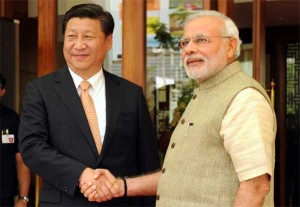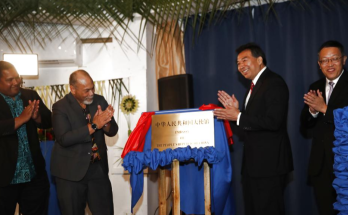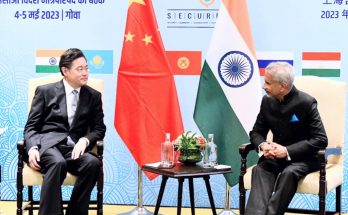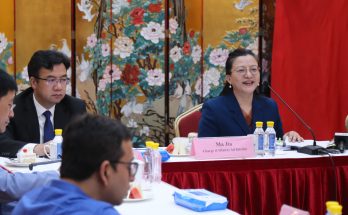 As the dust settles after the visit of Prime Minister Modi to China, it is time to take a calm and dispassionate look at where we stand in the context of Sino-Indian relations. Given space constraints, let us restrict our examination to the three vital issues of the boundary question, the huge trade imbalance and regional strategic concerns. Perhaps, it would be more worthwhile to initiate the process of assessment by first looking at what the Chinese have to say. We are, of course, not privy to what the Chinese leadership said to our Prime Minister in their meetings. That indeed must remain in the realm of confidentiality. But what is in the public domain, particularly in the tightly controlled Chinese media, does give us an inkling of the thinking of the Chinese leadership.
As the dust settles after the visit of Prime Minister Modi to China, it is time to take a calm and dispassionate look at where we stand in the context of Sino-Indian relations. Given space constraints, let us restrict our examination to the three vital issues of the boundary question, the huge trade imbalance and regional strategic concerns. Perhaps, it would be more worthwhile to initiate the process of assessment by first looking at what the Chinese have to say. We are, of course, not privy to what the Chinese leadership said to our Prime Minister in their meetings. That indeed must remain in the realm of confidentiality. But what is in the public domain, particularly in the tightly controlled Chinese media, does give us an inkling of the thinking of the Chinese leadership.
That there was no change in the Chinese position, both on the final settlement of the boundary question as also on Modi’s request for early clarification of the Line of Actual Control [LAC], was amply clear. Writing in the Chinese Communist Party [CCP] paper Global Times of 11 May 2015, Hu Zhiyong of the Shanghai Academy of Social Sciences stated that:
“Leaders from both China and India should not only strengthen mutual political trust, but also stick to a series of agreed principles and match their rhetoric with action. In light of this, Modi should no longer visit the disputed border region…. nor should he deliver any remarks that infringe on the consensus on bilateral ties. Meanwhile, the Indian government should completely stop supporting the Dalai Lama, and stop making the Tibetan issue a stumbling block to the Sino-Indian relationship.”
That Modi was clearly disenchanted with the Chinese attitude was spelt out in the presence of the Chinese Prime Minister Li Keqiang, when he exhorted China to “re-consider its approach on some of the issues that hold us back from realizing the full potential of our partnership”. It would be recalled that since November 1985 the Chinese have been insisting that India give “concessions in the eastern sector” for the boundary talks to proceed further.
Realizing that the two sides were going nowhere as regards the boundary negotiations, Modi was entirely right in urging that a ‘clarification’ of the LAC would be a positive step in eliminating the possibility of incursions. Speaking in public at the Tsinghua University, Modi urged the Chinese leadership to “resume the process of clarifying the LAC…without prejudice to our positions on the boundary question”. Even on this reasonable proposal there was deafening silence from the Chinese side. The reasons are obvious. In his letter of 4 November 1962, Premier Zhou Enlai had confirmed to Nehru that:
“In the east it [LAC] coincides with the McMahon Line [Note: word ‘so-called’ before McMahon Line is missing] and in the west and in the middle sector it coincides with the traditional boundary as put forth by the Chinese.”
So if in the east the LAC coincides with the McMahon Line according to Zhou’s letter, then it should be easy to demarcate it on the ground, for both the Indian and Chinese governments have a copy of the original McMahon map on which the McMahon Line is delineated. In the case of Myanmar, the Chinese had accepted the McMahon alignment of about 160 kilometres that covers the Sino-Myanmar sector.
It is obvious that in November 1962 Zhou made a tactical mistake by aligning the LAC with the McMahon Line. Realizing this, the Chinese have ever since then been trying to obfuscate the issue; for if you demarcate the LAC on the ground, you are actually demarcating the McMahon Line. The Chinese fear that once this is done, the demarcated LAC would itself, in course of time, evolve into the boundary. Perhaps Prime Minister Vajpayee also did not realize that he was letting the Chinese off the hook, when he conceded during his 2003 visit that the Sino-Indian boundary be negotiated “afresh, based on political parameters” [emphasis added]. Prime Minister Manmohan Singh also pursued the same line as Vajpayee when he negotiated the 2005 ‘Political Parameters and Guiding Principles for the Settlement of the Boundary Question’. It is not in the public domain whether Singh pushed for clarifications of the LAC subsequent to the last effort that petered out in 2005.
Thus it is entirely to the credit of Modi and National Security Advisor Doval that they have brought the focus back on first seeking clarifications of the LAC. It would require extreme dexterity on the part of Chinese diplomacy to wriggle out of the commitment of their former Prime Minister, particularly in the vital eastern sector.
On the trade deficit issue, Chinese commentators tried, once again, to put the onus back on India. Zhao Gancheng, Director South Asia Studies, Shanghai Institute for International Studies, wrote in the Global Times on 17 May 15 that:
“Even if New Delhi keeps persuading investors to do business in India…. the current situation is far from reassuring. Power failures happen frequently. There is a lack of decent roads and ports for transportation. Labor unrest occurs from time to time. Attracting investments against such backdrop will prove to be a major problem.”
Modi tried hard to dispel such adverse notions. He told his audience at Tsinghua University that,
“India is now the next frontier of the economic revolution. We have the demography for it. About 800 million people in India are below the age of 35 years… We have taken sweeping steps to reform our policies and open up more to foreign direct investments… We are eliminating unnecessary regulations and simplifying our procedures…. We are building a tax regime that is predictable, stable and competitive and scaling up investments in next generation infrastructure – roads, ports, railways, airports, telecom, digital networks and clean energy.”
Modi did well to set up a ‘task force’ to resolve ticklish trade issues, but it remains incomprehensible why the Chinese have been allowed to dump steel in India without corresponding measures. Chinese steel exports to India have gone up by 71 per cent this year. Both President Xi and PM Li did promise to bring down the trade deficit, but it remains to be seen how effective their promise is. Whether the Chinese were impressed by Modi’s intervention also remains to be seen.
On regional strategic issues, there seems to have been little movement. Although Modi stressed that “China’s support for India’s permanent membership of a reformed UN Security Council, and for India’s membership of export control regimes like Nuclear Suppliers Group will do more than just strengthen our international cooperation”, the Chinese simply acknowledged India’s desire without any commitments. On the other hand, a Chinese commentator openly stressed that:
“With the Maritime Silk Road, the AIIB, the China-Pak Economic Corridor and the surfacing of a Chinese nuclear submarine in Sri Lankan waters; Chinese ‘strength’ in the Indian Ocean Region has been demonstrated as never before.”
Thus giving forward traction to Sino-Indian relations remains a formidable task. It will take a number of high level visits, greater plain speaking and a more robust push for economic developments at home. Nevertheless, PM Modi’s visit is a task well begun, but it is only a small step forward.
(Courtesy of IDSA)
Author Profile
- India Writes Network (www.indiawrites.org) is an emerging think tank and a media-publishing company focused on international affairs & the India Story. Centre for Global India Insights is the research arm of India Writes Network. To subscribe to India and the World, write to editor@indiawrites.org. A venture of TGII Media Private Limited, a leading media, publishing and consultancy company, IWN has carved a niche for balanced and exhaustive reporting and analysis of international affairs. Eminent personalities, politicians, diplomats, authors, strategy gurus and news-makers have contributed to India Writes Network, as also “India and the World,” a magazine focused on global affairs.
Latest entries
 DiplomacyApril 10, 2024Diplomat-author Lakshmi Puri pitches for women power at LSR
DiplomacyApril 10, 2024Diplomat-author Lakshmi Puri pitches for women power at LSR India and the WorldApril 6, 2024UN envoy pitches to take India’s solutions to the world stage
India and the WorldApril 6, 2024UN envoy pitches to take India’s solutions to the world stage CultureApril 5, 2024Youth in Diplomacy: Making it Matter with LSR Model UN 2024
CultureApril 5, 2024Youth in Diplomacy: Making it Matter with LSR Model UN 2024 India and the WorldMarch 28, 2024India to China: Normalization of troops deployment imperative for restoring ties
India and the WorldMarch 28, 2024India to China: Normalization of troops deployment imperative for restoring ties







